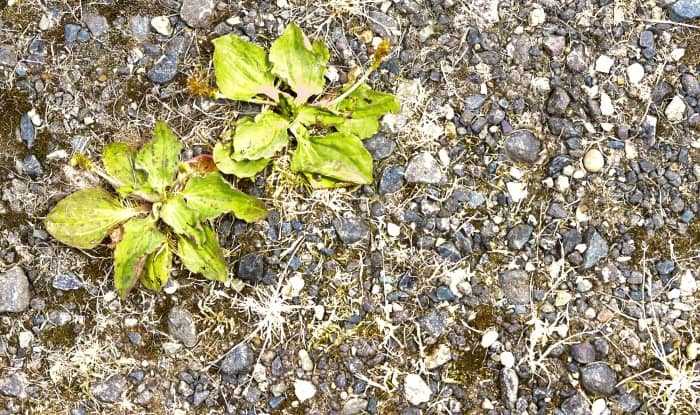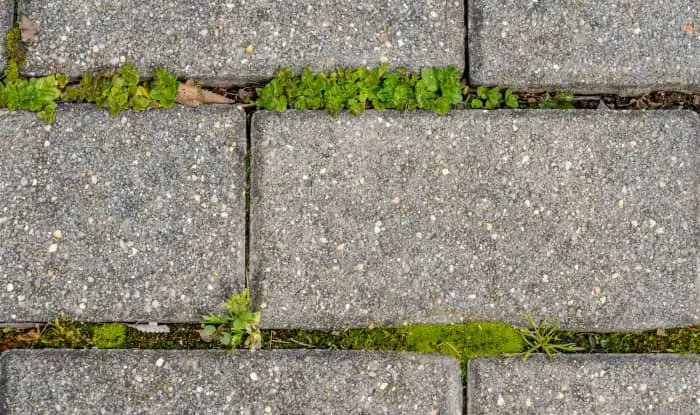Does bleach kill weeds and grass?
The short answer is yes. But before you grab the Clorox there’s more you need to know.
Bleach is very toxic to plants. So you have to be careful where you use it.
It’s good at taking care of weeds growing between the cracks in hard surfaces. But you don’t want to spray it around your lawn or flower beds.
So in this article, we’ll take a look at how it works and the best way to use it safely around your yard.
Let’s dive in.
How Effective Is Bleach?
Bleach (sodium hypochlorite) is poisonous to all life — bacteria, animals, insects, and plants. And with enough applications, it permanently eradicates unwanted plants and vegetation.
It does this by raising the pH of the soil to a level that’s inhospitable to plant growth. But this also means that bleach has limited usefulness.
It’s not a good idea to use this chemical in areas where you have desirable plants growing. Instead, you should only consider using it around hard surfaces, such as rocks and paving stones. And to treat gravel. But be aware that it can cause staining on brick pavers and patio stones.
All vegetation in the treated area will die. And because the alkalinity of the soil persists for a long time, you can stop the weeds from regrowing. Often preventing new growth for several months.
How Long Does It Take?
The results are noticeable quickly. After applying bleach the weeds usually wilt and turn brown within a few days.
But sometimes it can take longer. And you may need more than one application to get the job done.
It’s particularly effective at killing small weeds. But you’ll find it harder to eradicate large or highly invasive ones such as brambles, Ivy, or Japanese knotweed.
Usage Instructions
Bleach is easy to use:
1. First, put the undiluted bleach into a garden sprayer or you can pour it straight from the bottle.
2. Then carefully apply it to the weeds and moss growing between the cracks in your driveway, pavers, or patio. Make sure to soak the soil they are growing in.
3. Only use what you need. Don’t cover the hard surface with bleach as it will run off into nearby soil.
4. Wait for a few days. Then repeat the spraying in areas where the weeds are still alive.
5. After they die, it’s a good idea to pull them out to clean up your yard. Because the roots will also have died, the unwanted plants won’t regrow if the roots are left behind.
6. To help you dig out the weeds use a good tool.
Some stubborn weeds such as dandelion, crabgrass, horsetail, and creeping charlie may require multiple applications to eradicate them.
You should only use bleach in areas where you’re sure you don’t want to plant in the near future. But if you change your mind, you can attempt to change the soil conditions and make it less alkaline.
The chemical breaks down over time, leaving salts in the soil. Try to flush the bleach and the salts away by watering the area repeatedly. Use a soil pH meter to check your progress.
Precautions
Some extra things to consider:
It’s best to use bleach on a clear day with no rain. Why? Because rainfall will cause it to run into nearby areas of your garden, killing grass and desirable plants.
It’s also a good idea to make sure it’s not windy when you spray so that none of it gets onto nearby plants. And keep children and pets out of the way.
You should use safety equipment such as a good pair of gloves and eye protection.
Don’t use it near ponds, streams, and other aquatic environments.
Don’t mix it with other chemicals as it might react in unexpected ways.
Homemade Bleach Weed Killer Recipe
As well as using bleach to kill weeds on its own, you can also use it as an ingredient in homemade solutions.
Here’s a recipe for you to try:
Bleach & Salt
Salt also creates inhospitable conditions for plant growth when applied to the soil.
Some people add dish soap as well to act as a surfactant. But, you have to be very careful when adding dish soap to bleach as it can react, causing toxic fumes. So I don’t recommend it.
Here’s how to make it:
1. Dissolve salt in water using 1 cup of salt for every 2 cups of water.
2. Add bleach to the solution. The more it is diluted the weaker the effects will be.
3. Pour the solution into a weed sprayer.
4. Carefully spray the weeds with the mixture, making sure to cover each plant thoroughly.
Do I Recommend This Method?
To be honest, it isn’t near the top of my list for killing weeds. If you don’t have anything else it can do the job. But it’s not designed for this purpose and comes with significant drawbacks.
The possibility of damaging other plants in your garden as well as animals and insects is one problem.
And it can also find its way into the groundwater and other nearby sources of water, causing environmental harm.
If you do use it, It’s only really suitable for using small amounts to kill weeds in the cracks between pavers and in your driveway. And even then, there are options you can choose that are more suitable for the job.
And it’s certainly no use as a general herbicide around your yard. Unless you don’t mind killing everything and making the ground unsuitable for replanting.
Alternatives
If you decide against this method what else can you use?
High-strength vinegar is an effective natural herbicide that doesn’t pose the same level of risk to the environment. (see bleach vs vinegar).
You still need to be careful when using it. Because it’s non-selective it will kill plants on contact.
Salt is another option. You can use it on its own to eradicate weeds growing in the cracks between hard surfaces.
For more natural herbicides check out our guide to the best pet-safe herbicides.
And if you’re looking to use a chemical, then a more effective choice is a commercial product such as RoundUp. This uses the systemic herbicide glyphosate, killing the roots and preventing plants from growing.
You can also get selective chemical herbicides that are safe to use on your lawn because they don’t harm grass.



